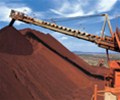Chinese Junk Could Sink The Profits Of Big Iron Ore Miners

Scrap steel in China is emerging as a significant threat to the future profits of the world’s biggest mining companies.
BHP, Rio Tinto, Anglo American, Vale and Fortescue Metals rely heavily on Chinese demand for steel made mainly from iron ore shipped from mines in Australia, Brazil and South Africa.
Locally mined material is also an important source of iron ore in China but another source, scrap steel, has played a lesser role than in other countries with big steel industries, such as Japan.
One estimate, from Morgan Stanley, an investment bank, is that scrap steel currently represents just 20% of the feedstock consumed by Chinese steel mills compared with 32% in Japan with its more developed economy.
Over the next 10 years years scrap use in Chinese steel making is expected to rise to approach Japan’s share, perhaps reaching 30% of overall steel mill feedstock by the year 2030.
More scrap in the mix almost certainly means reduced demand for iron ore which is the single most profitable material produced by BHP, Rio Tinto, Anglo American and Vale, and the only product currently produced by Fortescue.
What might happen to the iron ore price as China fine-tunes its scrap collection system and uses more of its locally “harvested” material will be closely watched by investors who have enjoyed bumper profits and sky-high share prices as Chinese Government economic stimulus in the wake of the Covid-19 pandemic has boosted steel demand.
Potential Iron Ore Price Crash
Morgan Stanley’s view, which is perhaps the most gloomy of the investment banks, is that high-grade iron ore could plunge from its current price of $130 a ton to $56/t after 2025, and perhaps to as low as $45/t if all of China’s “end of life” steel is recycled.
As well as facing a rising tide of scrap steel, iron ore miners are also confronting a natural decline in Chinese steel production as its economy matures.
Scrap consumption alone, estimated to reach 285 million tons by 2030 will displace 155m/t of iron ore demand, according to Morgan Stanley.
But, layered on top of the scrap stockpile is China’s declining overall steel output which the bank reckons will fall by 14% by 2030, eliminating demand for 200m/t of iron ore.
“This would bring the total decline in China’s ore demand to 355m/t (24%) from today’s levels, returning demand to 2012 levels,” Morgan Stanley said.
As early as 2025 the combination of scrap and natural steel demand decline could see the seaborne iron ore market dealing with an annual 100m/t surplus.
Steel scrap in China has not been an issue for the iron ore miners this year because the surge in steel demand took the steel mills by surprise and transport systems were slowed by pandemic mobility restrictions.
In a warning for investors, Morgan Stanley said iron ore miners were not pricing in scrap risks.
“Most iron ore equities price in a long-term price of $70/t versus our long term forecast of $56/t,” the bank said.
“Fortescue and Kumba (the Anglo American iron ore business) appear to price in the highest long-term price, thus reducing the appeal of their risk-reward profile.”
Source: Forbes

 Hellenic Shipping News Worldwide Hellenic Shipping News Worldwide, Online Daily Newspaper on Hellenic and International Shipping
Hellenic Shipping News Worldwide Hellenic Shipping News Worldwide, Online Daily Newspaper on Hellenic and International Shipping























 PG-Software
PG-Software